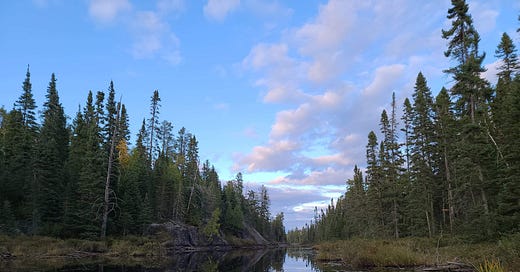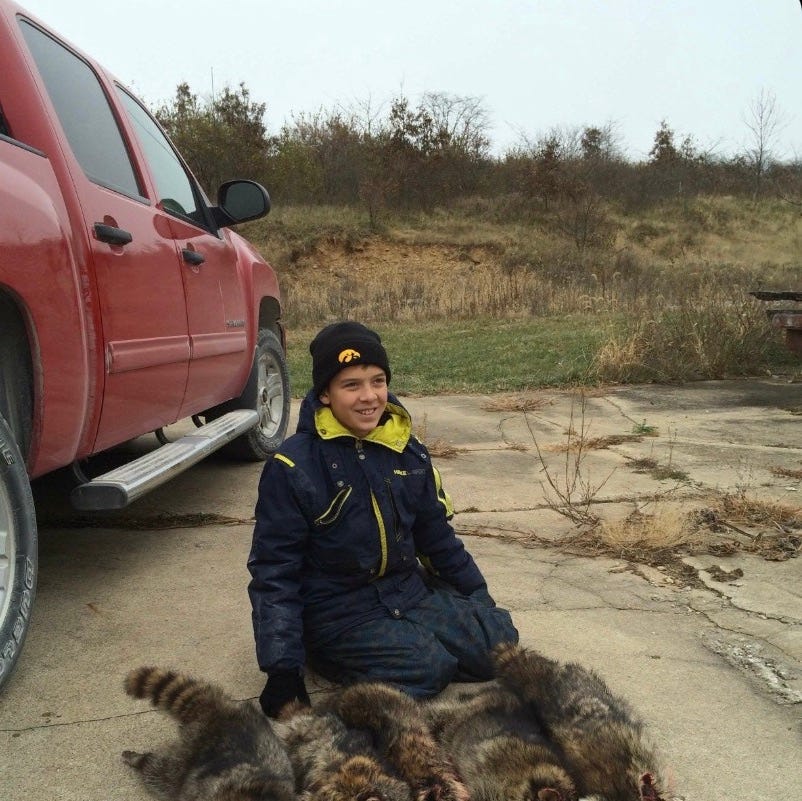The Hands That Shaped Me, the World We Must Protect
A Reflection on My Journey and the Road Ahead
I often get the question: How did you get interested in this? When did your love for nature begin? It’s always been a hard question to answer because, while I’ve had some important influences along the way, pinpointing exactly where the desire first started is difficult.
If I think back to the earliest moments of excitement and curiosity that nature sparked in me, I remember my four older brothers hurriedly rummaging through the house, gathering hunting gear and clothing. Their energy was contagious as they talked about rabbits and deer, the wilderness, snow, ice, and creeks, things I had never seen but desperately wanted to experience. I don’t remember exactly how young I was, but I know I hadn’t even been to preschool yet. I wanted so badly to join them on their adventure. I asked a million questions, hanging onto every detail they shared, trying to imagine the world they described. In my young mind, it became a dark, mysterious forest filled with rabbits, deer, coyotes, and icy streams.
As I entered grade school, my love for the outdoors took on a new form, this time through real adventures with my dad and his best friend, Uncle Todd. Come spring, I always wanted to go out with them, trailing along behind as they explored the woods. Of course, it didn’t hurt that every trip meant a special treat, Dad always bought me a drink and snack like Bug Juice and taffy sticks.
We would set out into what, to me, felt like a vast, untamed wilderness, though in reality, it was a local forested area or Uncle Todd’s farm. For hours I would follow them, mostly in silence. This was especially hard for me because I was always curious and would ask questions, and they would tell me about the trees, different kinds of mushrooms, animal tracks, and how to tell them apart. Every now and then, I’d stumble upon a mushroom and other times, Uncle Todd would grin and say, “Young man, go check that big old tree over there.”. Sure enough, there would be a mess of mushrooms waiting to be found. Uncle Todd was one of those sorts who always seemed to know the answer before he even asked the question. To my child’s mind, he and my dad had a gift, a way of reading nature that felt like magic.
As I entered first grade, I got ahold of a live trap and set it behind a shed in our backyard. Every morning, I would wake up with the excitement of a kid on Christmas morning. I was always itching to see what had fallen for the can of tuna and marshmallows I had left the night before. This was my way of getting up close and personal with nature, catching things like opossums, raccoons, and the occasional crazed alley cat.
Without fail, I would reset the trap each evening, check it first thing in the morning, let the critters out and then head off to Mrs. Hefner’s first-grade class. There I would eagerly share my latest backyard adventures. It was around this time that my curiosity about nature really took off. Mrs. Hefner had a way of making the natural world come alive with her lessons on monarch butterflies.
On occasion, her special friend, and now husband, Pete would visit our class to teach us about fossils, plants, and critters. To me, Pete was one of the coolest adults I had ever met. He knew so much about nature and wildlife, and he even talked about some of the very animals I had been trapping in my backyard. So you can imagine my joy when, one afternoon, Mrs. Hefner told me she was going to be my new neighbor.
After Pete and Mrs. Hefner (Sheryl) moved in across the street, I found myself making what seemed like daily visits to their home. There, I would bombard them with endless questions, whatever happened to be on the mind of a young lad who loved the great outdoors. They both still love to tell the story of the time they came over to my house and caught me catching songbirds under Mom’s bird feeder, right from the living room window. Using what looked like something straight out of a Wile E. Coyote cartoon, I had rigged up a trap with a box, birdseed, a stick, and a long piece of string.
With Pete and Sheryl as my mentors, I embarked on all sorts of adventures over the years, from hunting and trapping to tagging along when mammoth remains were discovered in Oskaloosa, Iowa. Sometimes, I helped Pete with his research on bison and seed dispersal, which involved sifting through bison dung with several screens to find seeds. Pete still laughs when he tells the story of my twin cringing and saying, “Eww, this is gross!” while I, without hesitation, exclaimed, “This isn’t gross! It… it… (sniffs air) smells like science!”
I also got to assist with small mammal research, checking cover boards and pitfall traps, learning firsthand how scientists studied the natural world.
As I reached middle school, Pete took me on my first real camping experience. We fished for trout and canoed down the Upper Iowa River. It was there that I discovered the joy of being fully immersed in nature, the sense of freedom it brought was unlike anything I had experienced before. Later, Pete became a professor and introduced me to one of my greatest friends and mentors, Jeremy.
When I first met Jeremy, he was a college student and one of Pete’s advisees. Whenever Pete was busy, Jeremy took me under his wing. We went trapping together, and I often tagged along as he conducted research on herpetofauna (Reptiles and amphibians) in grasslands. Over time, we went on camping trips with Pete, and eventually, we began setting out on our own adventures with other friends. Today, Jeremy continues to teach and guide me in the ways of being a modern-day naturalist and ecologist.
Now, friends, mentors, and teachers, like Dr. Estes, Jared, Holly, Vero, Megan, Dominic, and others, continue to teach me new things as we explore our shared interests together.
So I can’t say where it really began, but I do know that without the attention, love, and support from many people, including you reading this, I wouldn’t be where I am today.
I write all of this because I’ve been thinking a lot about the future of conservation, ecology, employment, and our natural places. In light of recent political moves and those yet to come that threaten the ecosystems, landscapes, and species that I and so many others have spent our lives understanding and protecting. It’s a challenging time. Sacred ecological systems are being destroyed or placed under threat, some of the last protectors of these places are being fired, and critical funding is being gutted. But if there’s one thing my mentors and loved ones have taught me, it’s that the work of those who protect is never done. It’s up to us, the ecologists, conservationists, curious minds, and adventurers. It’s up to you, reading this, to keep studying, protecting, fighting, and advocating for the natural world.
If not us, then who?
I don’t know what the future holds, but I do know this: I want to be a part of the solution, whether it is research, education, or simply sharing the wonder of nature with others. I want to give back to my community and nature herself, just as they have given to me, so that when it’s my turn to pass the torch, I can do so with pride, knowing I did my part.
Others I want to mention for helping me get to where I am today include Caitlin, Mom, Grandma, Tina, Kathy, Doug, Dan, Debra, Sheila, Jerry, Harold, Duffy, Casey, Todd, Brandon, James, Callie, Terry, Jordan, and all my friends, acquaintances, and especially to all of you taking the time to read this. Thank you.
If you enjoy reading nature Substacks I encourage you to check out Dr. Bob Leonard at Cedar Creek Nature Notes, Dian Porter at My Gaia, Larry Stone at Listening to the Land, Al Batt at Naturally Al Batt and Dr. Estes at
You wont be disappointed!“Love of nature is the spring from which stewardship flows. In contrast, disconnection from nature leads to apathy in the face of all environmental problems. A useful way to define love is sustained, compassionate attention. Paying sincere attention to, and developing a rich curiosity about others helps us to be kind. This attention takes work and improves with practice.” - John Muir Laws








Wonderful article